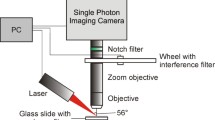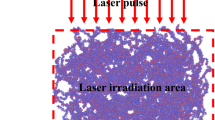Abstract
Low molecular weight polystyrene (∼10 kDa) was ablated with a free-electron laser at 3.31 and 3.43 μm and deposited as thin films on Si(100) substrates. The vibrational bands at 3.31 and 3.43 μm correspond to phenyl-ring CH and backbone CH2 modes, respectively. Even though the absorption coefficients of these two modes are nearly the same, the ablation yield was approximately 50% higher for the ring-mode excitation compared with the backbone mode. Based on spectral line width, the ring-mode lifetime is approximately triple that of the backbone mode, leading to a higher spatiotemporal density of vibrational excitation that more effectively disrupts the relatively weak Van der Waals bonds between neighboring polymer chains and consequently to higher ablation efficiency of the ring mode. Molecular weight assays of the deposited films showed that relatively little bond scission occurred and that the average molecular weight of the films was similar to that of the starting material.
Similar content being viewed by others
References
Bubb DM, Callahan JH, Horwitz JS, McGill RA, Houser EJ, Chrisey DB, Haglund RH, Papantonakis MR, Galicia M, Vertes A (2001) J. Vac. Sci. Technol. A 19:2698
Bubb DM, Papantonakis MR, Toftmann B, Horwitz JS, McGill RA, Chrisey DB, Haglund Jr RF (2002) J. Appl. Phys. 91:9809
Papantonakis MR, Haglund Jr RF (2004) Appl. Phys. A 79:1617
Tsuboi Y, Goto M, Itaya A (2001) J. Appl. Phys. 89:7917
See Blanchet GB (1996) J. Appl. Phys. 80:4082 and references therein
Srinivasan R, Braren B (1989) Chem. Rev. 89:1303
Yingling YG, Garrison BJ (2002) Chem. Phys. Lett. 364:237
Park HK, Haglund Jr RF (1997) Appl. Phys. A 64:431
Edwards GS, Evertson D, Gabella W, Grant R, King TL, Kozub J, Mendenhall M, Shen J, Shores R, Storms S, Traeger RH (1996) IEEE J. Sel. Top. Quantum Electron. 2:810
Bubb DM, Papantonakis MR, Horwitz JS, Haglund Jr RF, Toftmann B, McGill RA, Chrisey DB (2002) Chem. Phys. Lett. 352:135
Bubb DM, O’Malley SM, Antonacci C, Belmont R, McGill RA, Crimi C (2005) Appl. Phys. A 81:119
Dickinson JT (2001) Fracto-Emission, in Encyclopedia of Materials, Science and Technology, Buschow KHJ, Cahn RW, Flemings MC, Ilschner B, Kramer EJ, Mahajan S (eds). Elsevier, London, pp 3254–3256
Dickinson JT, Langford SC, Nakahara S, Scudiero L, Hipps KW, Kim M-W, Park N-S (1996) Spatial and temporal probes of fracture, wear, and deformation, In Fractography of Glasses and Ceramics III, Varner JR, Fréchette VD, Quinn GD (eds) (Ceram Trans Volc 64). American Ceramic Society, Westerville, OH, pp 193–256
Jones RAL (2002) Soft Condensed Matter. Oxford, New York
Chuang TJ, Hussla I (1984) Phys. Rev. Lett. 52:2045
Redlich B, van der Meer L, Zacharias H, Meijer G, von Helden G (2003) Nucl. Instrum. Methods Phys. Res. Sect. A 507:556
Braun R, Hess P (1993) J. Chem. Phys. 99:8330
Author information
Authors and Affiliations
Corresponding author
Additional information
PACS
61.41.+e; 78.30.-j; 81.05.Lg; 81.15.Fg
Rights and permissions
About this article
Cite this article
Bubb, D., Johnson, S., Belmont, R. et al. Mode-specific effects in resonant infrared ablation and deposition of polystyrene. Appl. Phys. A 83, 147–151 (2006). https://doi.org/10.1007/s00339-005-3478-8
Received:
Accepted:
Published:
Issue Date:
DOI: https://doi.org/10.1007/s00339-005-3478-8




